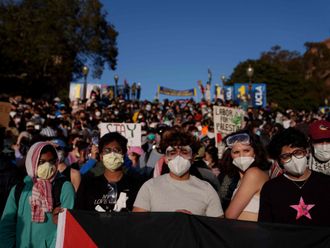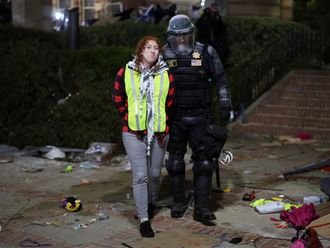Washington: The gruesome killing of a Jordanian pilot who had crashed in Daesh territory laid bare a problem of the US-led coalition — there is no sure way to rescue an airman who is down behind enemy lines. Now, in response, the US has moved search-and-rescue aircraft closer to the battlefield, defence officials said on Thursday.
US pilots are flying missions over Syria daily from bases in the region, including from Qatar, and partner nations, including Jordan, Saudi Arabia and Bahrain, are flying less often.
The risk of capture is unavoidable in air combat missions anywhere. The danger is arguably greater for pilots flying over Syria with no US troops nearby, even though Daesh has a very limited ability to shoot down planes.
The importance of finding the pilot before he is captured was highlighted by the video showing Daesh militants burning Jordanian Lt Muath Al Kasaesbeh alive in a cage.
The US has flown nearly 900 combat missions over Iraq since last August and more than 900 over Syria since September — not to mention hundreds of reconnaissance and other support missions — without a single loss. Coalition pilots have flown more than 350 air strike missions over Iraq and 80 or more over Syria, with Al Kasaeasbeh the only casualty so far.
Nonetheless, three defence officials said that in recent days the US has moved search-and-rescue aircraft into northern Iraq to shorten the response time in the event of another pilot loss. Al Kaseasbeh’s plane went down in December and he was quickly captured by Daesh fighters before US rescue crews could reach him.
The three officials spoke only on condition of anonymity because they were not authorised to speak on the record about a movement of rescue crews that has not been announced.
“It’s standard practice whenever US aircraft are flying over enemy airspace that there’s a search-and-rescue package ready to go,” said Peter Mansoor, a retired Army colonel who served in the Iraq war. But success is hardly sure, particularly when an enemy ground force can quickly grab the pilot.
‘Ramped it up’
That was the case with Al Kaseasbeh, whose F-16 crashed over Syria in December. He parachuted into a lake and was quickly captured, taken to an unknown location and held until he was killed on January 3. US officials have said an airborne search was launched after the pilot went down, but he stood no chance of evading capture.
“Given that we now know that captured pilots are likely to be tortured and killed, we’ve taken another look at our search-and-rescue package and probably ramped it up and gotten it closer to the scene of potential action,” Mansoor said in a telephone interview.
Combat missions also are being flown daily over portions of Iraq, mainly in the north and west. The majority are flown by American pilots, though France, Belgium, Britain, the Netherlands, Australia, Canada and Denmark also are flying missions.
On Thursday the US military said in its daily report on air strikes that coalition planes conducted three strikes in Syria overnight Wednesday and nine in Iraq.
The US typically keeps a tight lid on its combat search-and-rescue capabilities in war zones. The missions usually are led by the Air Force’s pararescue jumpers, or PJs, who undergo specialised training to be able to find, rescue and provide medical treatment to aircrew members who go down behind enemy lines or at sea.










_resources1_16a3106a819_small.jpg)

